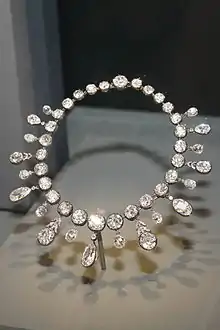Marie-Étienne Nitot
Marie-Étienne Nitot (born 2 April 1750 in Paris – deceased 9 September 1809) was a French jeweller, the official jeweller to the Emperor Napoleon, and the founder of the House of Chaumet.[1]
Marie-Étienne Nitot | |
|---|---|
.png.webp) Marie-Étienne Nitot | |
| Born | April 2, 1750 |
| Died | September 9, 1809 (aged 59) |
| Nationality | French |
| Known for | Official jeweller to the Emperor Napoleon Founder of the House of Chaumet |
History
Nitot's family was from Château-Thierry, he himself was born in Paris on 2 April 1750. After being an apprentice to Aubert, court jeweller to Queen Marie-Antoinette, he moved to Paris in 1780.[2]
He survived the French Revolution and, in 1802, was appointed jeweller to Emperor Napoleon. With the help of his son François Regnault (1779–1853), Nitot created jewellery symbolizing the power that Napoleon wished to convey.[3] These include the wedding jewels of Josephine de Beauharnais and Marie Louise of Austria. Nitot also designed Napoleon's coronation crown, his ceremonial sword and many other court ornaments.
Marie-Étienne Nitot also played an active role with his son into re-assembling the Crown Treasury (Trésor de la Couronne) dismantled and spread apart during and after the French revolution, and were exclusive providers of precious stones to Napoleon.[4]
Marie-Étienne Nitot died in 1809. Napoleon appointed his son François Regnault Nitot to succeed him. François Regnault Nitot operated until the fall of the empire in 1815.[5] Nitot then sold his business to his foreman, Jean-Baptiste Fossin (1786-1848).
Work
As official jeweller to Napoleon, Nitot made a number of significant pieces. He designed the Napoleon Tiara and the Imperial Sword. He also designed the Cameo Tiara for Joséphine before 1810, but no portraits of Joséphine wearing the Cameo exists (only one portrait of her daughter Hortense wearing the Cameo and dating from 1812 exists).[6] Marie-Étienne Nitot actually designed Joséphine's entire Emerald Parure that belongs today to the Royal family of Norway.[4]
The Leuchtenberg sapphire parure, now part of the Swedish royal family jewel foundation, is attributed to Nitot. The sapphires are thought to have been a wedding gift from Napoleon to his step-daughter Princess Augusta of Bavaria, Duchess of Leuchtenberg and then passed to the Swedish royal family with Queen Josephine.
Gallery
 Marie Louise Diadem by Francois Regnault Nitot.
Marie Louise Diadem by Francois Regnault Nitot.
 Cameo tiara, now in the Swedish Royal Family.
Cameo tiara, now in the Swedish Royal Family..jpg.webp) Queen Silvia wearing the Leuchtenberg Sapphire Parure.
Queen Silvia wearing the Leuchtenberg Sapphire Parure.
References
- "Milestones". Official website of Chaumet.
- Marie-Claude Gay (13 September 2018). Ana et le temps d'aimer (in French). De Borée.
- Henri Vever La bijouterie française au XIXe siècle (1800-1900) 1976 - Page 46 "Sa maison resta à l'un de ses quatre fils, qui était déjà son associé : François-Regnault Nitot, né à Paris en 1779. Ce dernier mourut le 19 janvier 1853, place Vendôme, n° 15, laissant une fille, devenue comtesse Treilhard, et cinq fils; l'un"
- Lareef A. Samad. "Belle Époque Pearl and Diamond "Collier De Chien" (Dog Collar) Necklace". Internetstones.com. Retrieved 26 December 2018.
- Nouvelles acquisitions du Département des objets d'art du Musée du Louvre. Département des objets d'art - 2003 "François-Regnault Nitot Paris, 1779-1853 : Après l'avoir secondé, il succède en 1809 à son père, Marie-Étienne Nitot, à la tête de la maison de joaillerie du 36, place du Carrousel; la maison est transférée 15, place Vendôme en ..."
- Ella Kay (9 March 2015). "Joséphine's jewels: Myths and legends". Thecourtjeweller.com. Retrieved 26 December 2018.